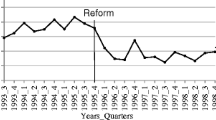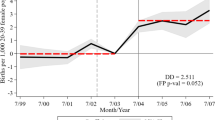Abstract
This article compares the employmentpatterns of women after first and second birthin Finland, Norway and Sweden during 1972–1992,focusing on the impact of parental leave andchildcare programs on the transitions tofull-time and part-time work. The resultsunanimously point to the great importance ofthe programs. Women who are entitled to a paidleave have a much higher overall employmententry rate during the first three yearsfollowing birth than non-eligible women.But since mothers tend to use their fullentitlement, the higher entry rates are largelyconcentrated to the period after leave expiry,except in Sweden where entitled mothers havehigher entry rates also during the leaveperiod. This is probably a result of thegreater flexibility of the Swedish program. Inall countries, leave extensions delay thereturn to work among entitled mothers andreduce their excess entry rate. Moreover, theFinnish home-care allowance system is found toreduce employment entry. On the whole, thissuggests that very long leave entitlements andchild-minding benefit programs could havenegative consequences for women's career andearnings potentials and may preserve an unequaldivision of labour in the family.
Similar content being viewed by others
References
Albrecht, J. W., Edin, P. A., Sundström, M. and Vroman, S. B., 1999. ‘Career interruptions and subsequent earnings: a reexamination using Swedish data'. Journal of Human Resources 34: 294–311.
Barrow, L., 1996. ‘An analysis of women's labor force participation following first birth'. Working paper 363, Industrial Relations Section, Princeton University.
Brandth, B. and Jensberg, J., 1998.’ Suksess for fedrekvoten’ ('success for the fathers’ quota'). Velferd No. 4.
Brunin, G. and Plantenga J., 1999. ‘Parental leave and equal opportunities: experiences in eight European countries'. Journal of European Social Policy 9: 195–209.
Cox, D. R., 1972. ‘Regression models and life-tables (with discussion)'. Journal of the Royal Statistical Society B 34: 187–220.
Even, W. E., 1987. ‘Career interruptions following childbirth'. Journal of Labour Economics 5: 255–277.
Gronau, R., 1988. ‘Sex-related wage differentials and women's interrupted labour careers - the chicken or the egg'. Journal of Labour Economics 6: 277–301.
Gustafsson, S. S. and Stafford, F., 1994. ‘Three regimes of child care', in R. Blank (ed), Social Protection Versus Economic Flexibility: Is there a Tradeoff?. University of Chicago Press, Chicago, 333–361.
Hoem, B., 1995. Kvinnors och mäns liv. Del 1 Sysselsättning från 18 års ålder. Statistics Sweden, Stockholm.
Hoem, J. M., 1993. ‘Public policy as the fuel of fertility'. Acta Sociologica 36: 19–31.
Hotz, J. V. and Miller, R. A., 1988. ‘An empirical analysis of life cycle fertility and female labour supply'. Econometrica 56: 91–118.
Håkonsen, L., Kornstad, T., Løyland, K. and Thoresen, T. O., 2001. ‘Kontantstøtten - effekter på arbeidstilbud og inntektsfordeling’ ('The Cash-for-care benefit - effects on labour supply and income distribution'). Reports 2001/5, Statistics Norway.
Ilmakunnas, S., 1997. ‘Public policy and child care choice', in I. Persson and C. Jonung (eds), Economics of Family and Family Policy. Routledge, London, 178–193.
Joesch, J. M., 1994. ‘Children and the timing of women's paid work after childbirth'. Journal of Marriage and the Family 56: 429–440.
Joesch, J. M., 1997. ‘Paid leave and the timing of women's employment before and after childbirth'. Journal of Marriage and the Family 59: 1008–1021.
Jonsson, J. O. and Mills, C., forthcoming. ‘Giving birth without giving up', in J. O. Jonsson and C. Mills (eds), Cradle to Grave. Life-Course Changes in Modern Sweden. Sociology press, Durham.
Kamerman, S. B., 1991. ‘Child care policies and programs: an international overview'. Journal of Social Issues 47: 179–196.
Klerman, J. A. and Leibowitz, A., 1999. ‘Job continuity among new mothers'. Demography 36: 145–155.
Kravdal, Ø., 1992a. ‘The weak impact of female labour-force participation on Norwegian third-birth rates'. European Journal of Population 8: 247–263.
Kravdal, Ø., 1992b. ‘Foregone labour participation and earning due to childbearing among Norwegian women'. Demography 29: 545–563.
Leibowitz, A., Klerman, J. A. and Waite, L. J., 1992. ‘Employment of new mothers and child care choice'. Journal of Human Resources 27: 112–133.
Nordic Council of Ministers, 1995. Yearbook of Nordic statistics. Copenhagen.
Nätti, J., 1995. ‘Part-time work in the Nordic countries: a trap for women?'. Labour 9: 343–357.
Ondrich, J., Spiess, C. K. and Yang, Q., 1996. ‘Barefoot in a German kitchen: federal parental leave and benefit policy and the return to work after childbirth in Germany'. Journal of Population Economics 9: 247–266.
Ondrich, J., Spiess, C. K., Yang, Q. and Wagner, G. G., 1999. ‘Full time or part time? German parental leave policy and the return to work after childbirth in Germany'. Research in Labor Economics 18: 41–74.
Pfau-Effinger, B., 1993. ‘Modernisation, culture and part-time employment: the example of Finland and West Germany'. Work, Employment and Society 7: 383–410.
Rønsen, M., 2001. ‘Market work, child care and the division of household labour. Adaptations of Norwegian mothers before and after the cash-for-care reform'. Reports 2001/3, Statistics Norway.
Rønsen, M. and Sundström, M., 1996. ‘Maternal employment in Scandinavia'. Journal of Population Economics 9: 267–285.
Rønsen, M. and Sundström, M., 1999. ‘Public policies and the employment dynamics among new mothers - a comparison of Finland, Norway and Sweden'. Discussion Papers 263, Statistics Norway.
Ruhm, C. J., 1998. ‘The economic consequences of parental leave mandates'. Quarterly Journal of Economics 113: 285–317.
Salmi, M., 1994. ‘The parental leave and day care systems in Finland'. National Research and Development Centre for Welfare and Health (STAKES), Helsinki.
Salmi, M., 1999. ‘Parental leave in Finland', in P. Moss and F. Deven (eds), Parental Leave: Progress or Pitfall? NIDI/CBGS Publications, Vol. 35, The Hague/Brussels.
Shapiro, D. and Mott, F. L., 1994. ‘Long-term employment and earnings of women in relation to employment behavior surrounding the first birth'. Journal of Human Resources 29: 248–275.
Shaw, K., 1994. ‘The persistence of female labour supply'. Journal of Human Resources 29: 348–378.
Sivertsen, A. M., 1996. ‘Fødselspengemotivert inntektsutvikling - en økonometrisk analyse’ ('Maternity benefit motivated income change - an econometric analysis'). M. Sc. thesis, Institute of Economics, University of Bergen.
Sundström, M. and Duvander, A. Z. (2000). ‘Family division of childcare and the sharing of parental leave among new parents in Sweden', in A. Z. Duvander, Couples in Sweden. Studies on family and work. Swedish Institute for Social Research - Dissertation Series 46, Stockholm University.
Author information
Authors and Affiliations
Corresponding author
Rights and permissions
About this article
Cite this article
Rønsen, M., Sundström, M. Family Policy and After-Birth Employment Among New Mothers – A Comparison of Finland, Norway and Sweden. European Journal of Population 18, 121–152 (2002). https://doi.org/10.1023/A:1015532305179
Issue Date:
DOI: https://doi.org/10.1023/A:1015532305179




